Change Patterns of Ecological Vulnerability and Its Dominant Factors in Mongolia During 2000–2022
Abstract
1. Introduction
2. Materials and Methods
2.1. Study Area
2.2. Data Resources
2.3. Principal Component Analysis
2.4. Kappa Coefficient
2.5. Gravity Center
2.6. Geo–Detector Model
2.7. Ecological Vulnerability Indicators
2.7.1. Vegetation Index
2.7.2. Soil Moisture Index
2.7.3. Heat Index
2.7.4. Land Degradation Index
2.7.5. Human Disturbance Index
2.8. Construction of Remote Sensing Ecological Vulnerability Index
2.8.1. Remote Sensing Ecological Vulnerability Index
2.8.2. Classification of Ecological Vulnerability Index Using Remote Sensing
2.9. Eco–Geographical Division of Mongolia
3. Results
3.1. Verifying the Accuracy of Remote Sensing Ecological Vulnerability Index
3.2. Spatial Distribution of Remote Sensing Ecological Vulnerability
3.3. Gravity Center Model
3.4. Dominant Factors in Different Sub–Regions of Mongolia
4. Discussion
4.1. The Advantages of the Remote Sensing Ecological Vulnerability Index
4.2. Spatial Distribution Analysis of Remote Sensing Ecological Vulnerability
4.3. Dominant Factors of Ecological Vulnerability
5. Conclusions
- From 2000 to 2022, the average remote sensing ecological vulnerability index of Mongolia was 1.57, classified as mild vulnerability. The area of mild vulnerability constitutes the largest proportion.
- Between 2000 and 2022, the gravity center of Mongolia’s ecological vulnerability shifted toward the southwest, indicating that the degree of ecological vulnerability intensification in the southwest region was greater than that in the northeast region.
- From 2000 to 2022, Tmax was the dominant driving factor of ecological vulnerability in Mongolia, with the dominant interactive factor transitioning from Tmax ∩ Tmin to Tmin ∩ PRE. For the eastern, central, and southern regions of Mongolia, PRE was the dominant factor, and PRE ∩ DEM was the dominant interactive factor. In the western and northwestern regions, the dominant factor shifted from Tmax and Tmin to DEM and LC, and the dominant interactive factor evolved from Tmax ∩ Tmin, Tmin ∩ PRE to PRE ∩ DEM, LC ∩ DEM.
Author Contributions
Funding
Data Availability Statement
Conflicts of Interest
References
- Nilsson, C.; Grelsson, G. The fragility of ecosystems: A review. J. Appl. Ecol. 1995, 32, 677–692. [Google Scholar]
- Wang, Q.; Wang, H. Evaluation for the spatiotemporal patterns of ecological vulnerability and habitat quality: Implications for supporting habitat conservation and healthy sustainable development. Environ. Geochem. Health 2023, 45, 2117–2147. [Google Scholar] [PubMed]
- Liu, H.-L.; Willems, P.; Bao, A.-M.; Wang, L.; Chen, X. Effect of climate change on the vulnerability of a socio-ecological system in an arid area. Glob. Planet. Change 2016, 137, 1–9. [Google Scholar] [CrossRef]
- Jodha, N.S. Globalization and fragile mountain environments. Mt. Res. Dev. 2000, 20, 296–299. [Google Scholar] [CrossRef]
- Liu, Y.; Zhang, Y.; Guo, L. Towards realistic assessment of cultivated land quality in an ecologically fragile environment: A satellite imagery-based approach. Appl. Geogr. 2010, 30, 271–281. [Google Scholar] [CrossRef]
- Inman, D.L.; Brush, B.M. The Coastal Challenge: Fragile ribbons which border our land require more understanding, new technology, and resolute planning. Science 1973, 181, 20–32. [Google Scholar]
- Zhao, H.; Xu, X.; Tang, J.; Wang, Z.; Miao, C. Spatial pattern evolution and prediction scenario of habitat quality in typical fragile ecological region, China: A case study of the Yellow River floodplain area. Heliyon 2023, 9, e14430. [Google Scholar] [CrossRef]
- Olafsdottir, R.; Runnström, M.C. A GIS approach to evaluating ecological sensitivity for tourism development in fragile environments. A case study from SE Iceland. Scand. J. Hosp. Tour. 2009, 9, 22–38. [Google Scholar] [CrossRef]
- Xu, H.; Xu, F.; Lin, T.; Xu, Q.; Yu, P.; Wang, C.; Aili, A.; Zhao, X.; Zhao, W.; Zhang, P.; et al. A systematic review and comprehensive analysis on ecological restoration of mining areas in the arid region of China: Challenge, capability and reconsideration. Ecol. Indic. 2023, 154, 110630. [Google Scholar] [CrossRef]
- Farnworth, E.G.; Golley, F.B. Fragile Ecosystems: Evaluation of Research and Applications in the Neotropics; Springer Science & Business Media: Berlin/Heidelberg, Germany, 2013. [Google Scholar]
- Hong, W.; Jiang, R.; Yang, C.; Zhang, F.; Su, M.; Liao, Q. Establishing an ecological vulnerability assessment indicator system for spatial recognition and management of ecologically vulnerable areas in highly urbanized regions: A case study of Shenzhen, China. Ecol. Indic. 2016, 69, 540–547. [Google Scholar] [CrossRef]
- Jiang, Y.; Shi, B.; Su, G.; Lu, Y.; Li, Q.; Meng, J.; Ding, Y.; Song, S.; Dai, L. Spatiotemporal analysis of ecological vulnerability in the Tibet Autonomous Region based on a pressure-state-response-management framework. Ecol. Indic. 2021, 130, 108054. [Google Scholar] [CrossRef]
- Polsky, C.; Neff, R.; Yarnal, B. Building comparable global change vulnerability assessments: The vulnerability scoping diagram. Glob. Environ. Change 2007, 17, 472–485. [Google Scholar] [CrossRef]
- Chen, X.; Li, X.; Eladawy, A.; Yu, T.; Sha, J. A multi-dimensional vulnerability assessment of Pingtan Island (China) and Nile Delta (Egypt) using ecological Sensitivity-Resilience-Pressure (SRP) model. Hum. Ecol. Risk Assess. Int. J. 2021, 27, 1860–1882. [Google Scholar] [CrossRef]
- Eakin, H.; Luers, A.L. Assessing the vulnerability of social-environmental systems. Annu. Rev. Environ. Resour. 2006, 31, 365–394. [Google Scholar] [CrossRef]
- Malekmohammadi, B.; Jahanishakib, F. Vulnerability assessment of wetland landscape ecosystem services using driver-pressure-state-impact-response (DPSIR) model. Ecol. Indic. 2017, 82, 293–303. [Google Scholar] [CrossRef]
- Eckert, S.; Hüsler, F.; Liniger, H.; Hodel, E. Trend analysis of MODIS NDVI time series for detecting land degradation and regeneration in Mongolia. J. Arid. Environ. 2015, 113, 16–28. [Google Scholar] [CrossRef]
- Shah, M.A.R.; Wang, X. Assessing social-ecological vulnerability and risk to coastal flooding: A case study for Prince Edward Island, Canada. Int. J. Disaster Risk Reduct. 2024, 106, 104450. [Google Scholar] [CrossRef]
- Huang, B.; Zha, R.; Chen, S.; Zha, X.; Jiang, X. Fuzzy evaluation of ecological vulnerability based on the SRP-SES method and analysis of multiple decision-making attitudes based on OWA operators: A case of Fujian Province, China. Ecol. Indic. 2023, 153, 110432. [Google Scholar] [CrossRef]
- Zhang, Q.; Wang, G.; Yuan, R.; Singh, V.P.; Wu, W.; Wang, D. Dynamic responses of ecological vulnerability to land cover shifts over the Yellow River Basin, China. Ecol. Indic. 2022, 144, 109554. [Google Scholar] [CrossRef]
- Cai, X.; Li, Z.; Liang, Y. Tempo-spatial changes of ecological vulnerability in the arid area based on ordered weighted average model. Ecol. Indic. 2021, 133, 108398. [Google Scholar] [CrossRef]
- Pirasteh, S.; Fang, Y.; Mafi-Gholami, D.; Abulibdeh, A.; Nouri-Kamari, A.; Khonsari, N. Enhancing vulnerability assessment through spatially explicit modeling of mountain social-ecological systems exposed to multiple environmental hazards. Sci. Total Environ. 2024, 930, 172744. [Google Scholar] [CrossRef]
- Abson, D.J.; Dougill, A.J.; Stringer, L.C. Using principal component analysis for information-rich socio-ecological vulnerability mapping in Southern Africa. Appl. Geogr. 2012, 35, 515–524. [Google Scholar]
- Tang, Q.; Wang, J.; Jing, Z. Tempo-spatial changes of ecological vulnerability in resource-based urban based on genetic projection pursuit model. Ecol. Indic. 2021, 121, 107059. [Google Scholar]
- Helldén, U.; Tottrup, C. Regional desertification: A global synthesis. Glob. Planet. Change 2008, 64, 169–176. [Google Scholar]
- Alexander, L.V.; Zhang, X.; Peterson, T.C.; Caesar, J.; Gleason, B.; Klein Tank, A.; Haylock, M.; Collins, D.; Trewin, B.; Rahimzadeh, F.; et al. Global observed changes in daily climate extremes of temperature and precipitation. J. Geophys. Res. Atmos. 2006, 111, 1042–1063. [Google Scholar]
- Rao, M.P.; Davi, N.K.; D D’Arrigo, R.; Skees, J.; Nachin, B.; Leland, C.; Lyon, B.; Wang, S.-Y.; Byambasuren, O. Dzuds, droughts, and livestock mortality in Mongolia. Environ. Res. Lett. 2015, 10, 074012. [Google Scholar]
- Yuan, J.; Chen, J.; Sciusco, P.; Kolluru, V.; Saraf, S.; John, R.; Ochirbat, B. Land use hotspots of the two largest landlocked countries: Kazakhstan and Mongolia. Remote Sens. 2022, 14, 1805. [Google Scholar] [CrossRef]
- Batima, P.; Natsagdorj, L.; Gombluudev, P.; Erdenetsetseg, B. Observed climate change in Mongolia. Assess. Impacts Adapt. Clim. Change 2005, 12, 1–26. [Google Scholar]
- Tamura, K.; Asano, M.; Jamsran, U. Soil diversity in Mongolia. In The Mongolian Ecosystem Network: Environmental Issues Under Climate and Social Changes; Springer: Tokyo, Japan, 2013; pp. 99–103. [Google Scholar]
- Batjargal, Z. Desertification in Mongolia. RALA Rep. 1997, 200, 107–113. [Google Scholar]
- Foggin, J.M.; Smith, A.T. Rangeland utilization and biodiversity on the alpine grasslands of Qinghai Province, People’s Republic of China. In Conserving China’s Biodiversity II; China Environmental Science Press: Beijing, China, 1996; pp. 247–258. [Google Scholar]
- Dwyer, J.; Schmidt, G. The MODIS reprojection tool. In Earth Science Satellite Remote Sensing: Vol. 2: Data, Computational Processing, and Tools; Springer: Berlin/Heidelberg, Germany, 2006; pp. 162–177. [Google Scholar]
- Wold, S.; Esbensen, K.; Geladi, P. Principal component analysis. Chemom. Intell. Lab. Syst. 1987, 2, 37–52. [Google Scholar]
- Wan, T.; Hu, J.; Wu, P.; He, H. Kappa Coefficient: A Popular Measure of Rater Agreement. Shanghai Arch. Psychiatry 2015, 27, 62. [Google Scholar]
- Zhu, L.; Meng, J.; Zhu, L. Applying Geodetector to disentangle the contributions of natural and anthropogenic factors to NDVI variations in the middle reaches of the Heihe River Basin. Ecol. Indic. 2020, 117, 106545. [Google Scholar]
- Bai, Z.G.; Dent, D.L.; Olsson, L.; Schaepman, M.E. Proxy global assessment of land degradation. Soil Use Manag. 2008, 24, 223–234. [Google Scholar] [CrossRef]
- Hall, F.; Masek, J.G.; Collatz, G.J. Evaluation of ISLSCP Initiative II FASIR and GIMMS NDVI products and implications for carbon cycle science. J. Geophys. Res. Atmos. 2006, 111, D22S08. [Google Scholar]
- Hunt, E.D.; Hubbard, K.G.; Wilhite, D.A.; Arkebauer, T.J.; Dutcher, A.L. The development and evaluation of a soil moisture index. Int. J. Climatol. 2009, 29, 747. [Google Scholar]
- Houborg, R.; Soegaard, H.; Boegh, E. Combining vegetation index and model inversion methods for the extraction of key vegetation biophysical parameters using Terra and Aqua MODIS reflectance data. Remote Sens. Environ. 2007, 106, 39–58. [Google Scholar] [CrossRef]
- Pettorelli, N.; Vik, J.O.; Mysterud, A.; Gaillard, J.-M.; Tucker, C.J.; Stenseth, N.C. Using the satellite-derived NDVI to assess ecological responses to environmental change. Trends Ecol. Evol. 2005, 20, 503–510. [Google Scholar] [CrossRef]
- Yue, W.; Xu, J.; Tan, W.; Xu, L. The relationship between land surface temperature and NDVI with remote sensing: Application to Shanghai Landsat 7 ETM+ data. Int. J. Remote Sens. 2007, 28, 3205–3226. [Google Scholar]
- Sun, D.; Kafatos, M. Note on the NDVI-LST relationship and the use of temperature-related drought indices over North America. Geophys. Res. Lett. 2007, 34, L24406. [Google Scholar]
- Yembuu, B. Climate and Climate Change of Mongolia. In The Physical Geography of Mongolia; Springer: Berlin/Heidelberg, Germany, 2021; pp. 51–76. [Google Scholar]
- Miao, L.; Fraser, R.; Sun, Z.; Sneath, D.; He, B.; Cui, X. Climate impact on vegetation and animal husbandry on the Mongolian plateau: A comparative analysis. Nat. Hazards 2016, 80, 727–739. [Google Scholar] [CrossRef]
- Nanzad, L.; Zhang, J.; Tuvdendorj, B.; Nabil, M.; Zhang, S.; Bai, Y. NDVI anomaly for drought monitoring and its correlation with climate factors over Mongolia from 2000 to 2016. J. Arid. Environ. 2019, 164, 69–77. [Google Scholar]
- Nandintsetseg, B.; Boldgiv, B.; Chang, J.; Ciais, P.; Davaanyam, E.; Batbold, A.; Bat-Oyun, T.; Stenseth, N.C. Risk and vulnerability of Mongolian grasslands under climate change. Environ. Res. Lett. 2021, 16, 034035. [Google Scholar] [CrossRef]
- Avidsuren, E. Risk Assessment of Grassland Degradationin Arhangai, Mongolia. Ph.D. Thesis, Inner Mongolia Agricultural University, Hohhot, China, 2021. [Google Scholar]
- Xu, S.; Wang, J.; Altansukh, O.; Chuluun, T. Spatiotemporal evolution and driving mechanisms of desertification on the Mongolian Plateau. Sci. Total Environ. 2024, 941, 173566. [Google Scholar]
- Nandintsetseg, B.; Greene, J.S.; Goulden, C.E. Trends in extreme daily precipitation and temperature near Lake Hövsgöl, Mongolia. Int. J. Climatol. A J. R. Meteorol. Soc. 2007, 27, 341–347. [Google Scholar]
- Peng, S.; Piao, S.; Ciais, P.; Myneni, R.B.; Chen, A.; Chevallier, F.; Dolman, A.J.; Janssens, I.A.; Penuelas, J.; Zhang, G. Asymmetric effects of daytime and night-time warming on Northern Hemisphere vegetation. Nature 2013, 501, 88–92. [Google Scholar]
- Shen, M.; Piao, S.; Chen, X.; An, S.; Fu, Y.H.; Wang, S.; Cong, N.; Janssens, I.A. Strong impacts of daily minimum temperature on the green-up date and summer greenness of the Tibetan Plateau. Glob. Change Biol. 2016, 22, 3057–3066. [Google Scholar]
- Sheffield, J.; Wood, E.F. Projected changes in drought occurrence under future global warming from multi-model, multi-scenario, IPCC AR4 simulations. Clim. Dyn. 2008, 31, 79–105. [Google Scholar]
- Goulden, C.E.; Mead, J.; Horwitz, R.; Goulden, M.; Nandintsetseg, B.; McCormick, S.; Boldgiv, B.; Petraitis, P.S. Interviews of Mongolian herders and high resolution precipitation data reveal an increase in short heavy rains and thunderstorm activity in semi-arid Mongolia. Clim. Change 2016, 136, 281–295. [Google Scholar]
- Bao, G.; Tuya, A.; Bayarsaikhan, S.; Dorjsuren, A.; Mandakh, U.; Bao, Y.; Li, C.; Vanchindorj, B. Variations and climate constraints of terrestrial net primary productivity over Mongolia. Quat. Int. 2020, 537, 112–125. [Google Scholar]
- Hannam, I. Human dimensions of soil and water conservation: Mongolia. In Human Dimensions of Soil and Water Conservation; Nova Science Publishers: New York, NY, USA, 2010; pp. 341–356. [Google Scholar]
- Wang, J.; Brown, D.G.; Agrawal, A. Sustainable governance of the Mongolian grasslands: Comparing ecological and social-institutional changes in the context of climate change in Mongolia and Inner Mongolia, China. In Dryland East Asia: Land Dynamics amid Social and Climate Change; De Gruyter: Berlin, Germany, 2014; pp. 423–444. [Google Scholar]
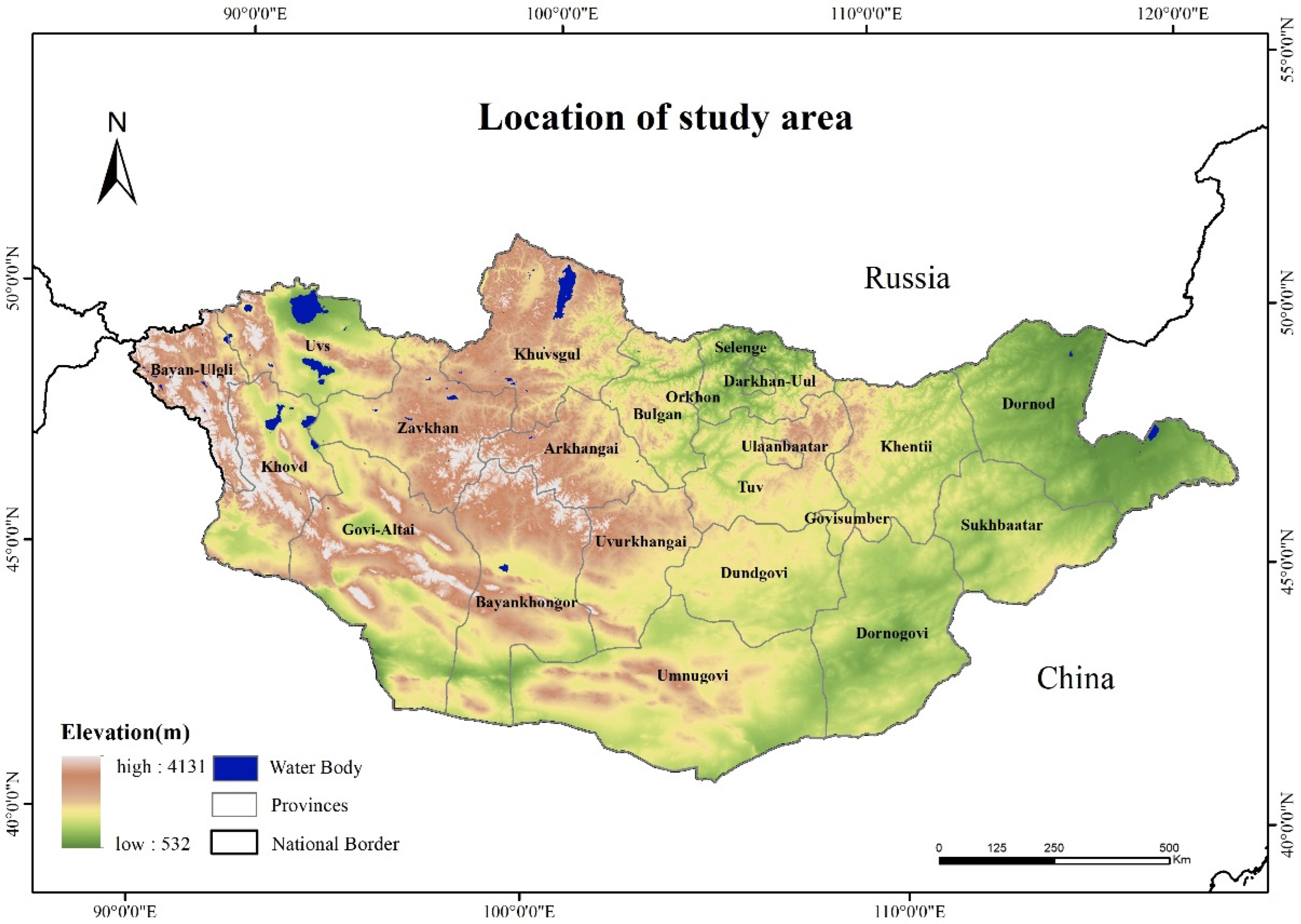
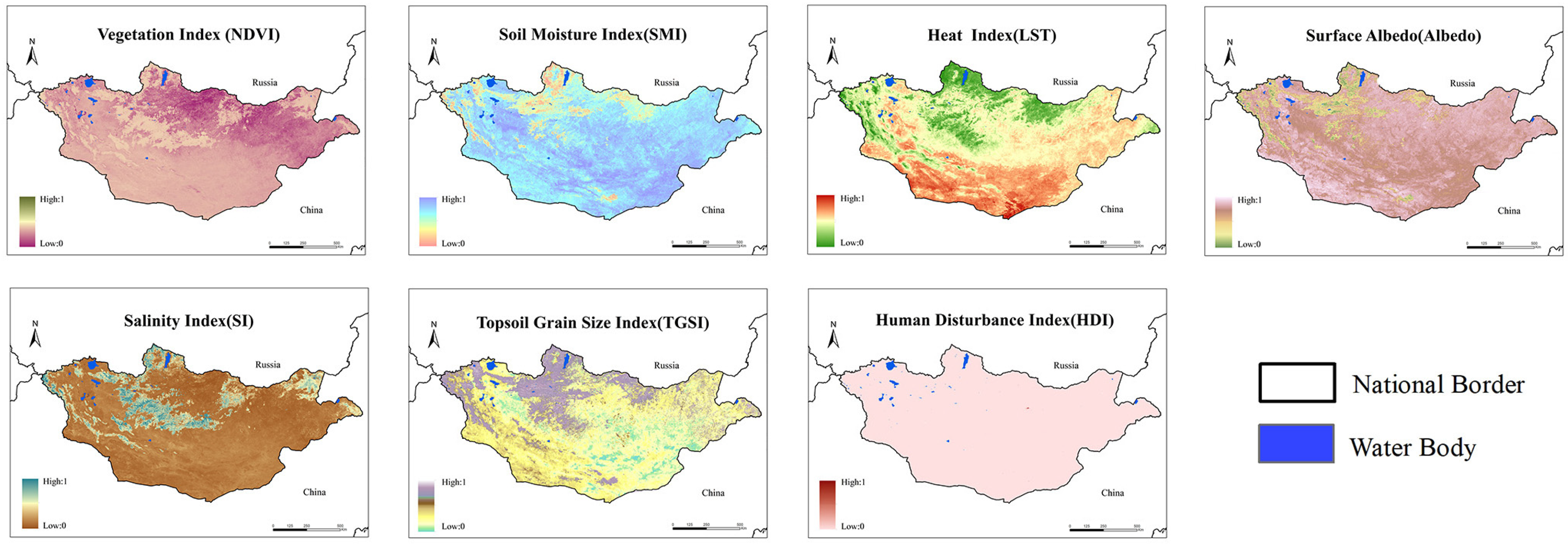
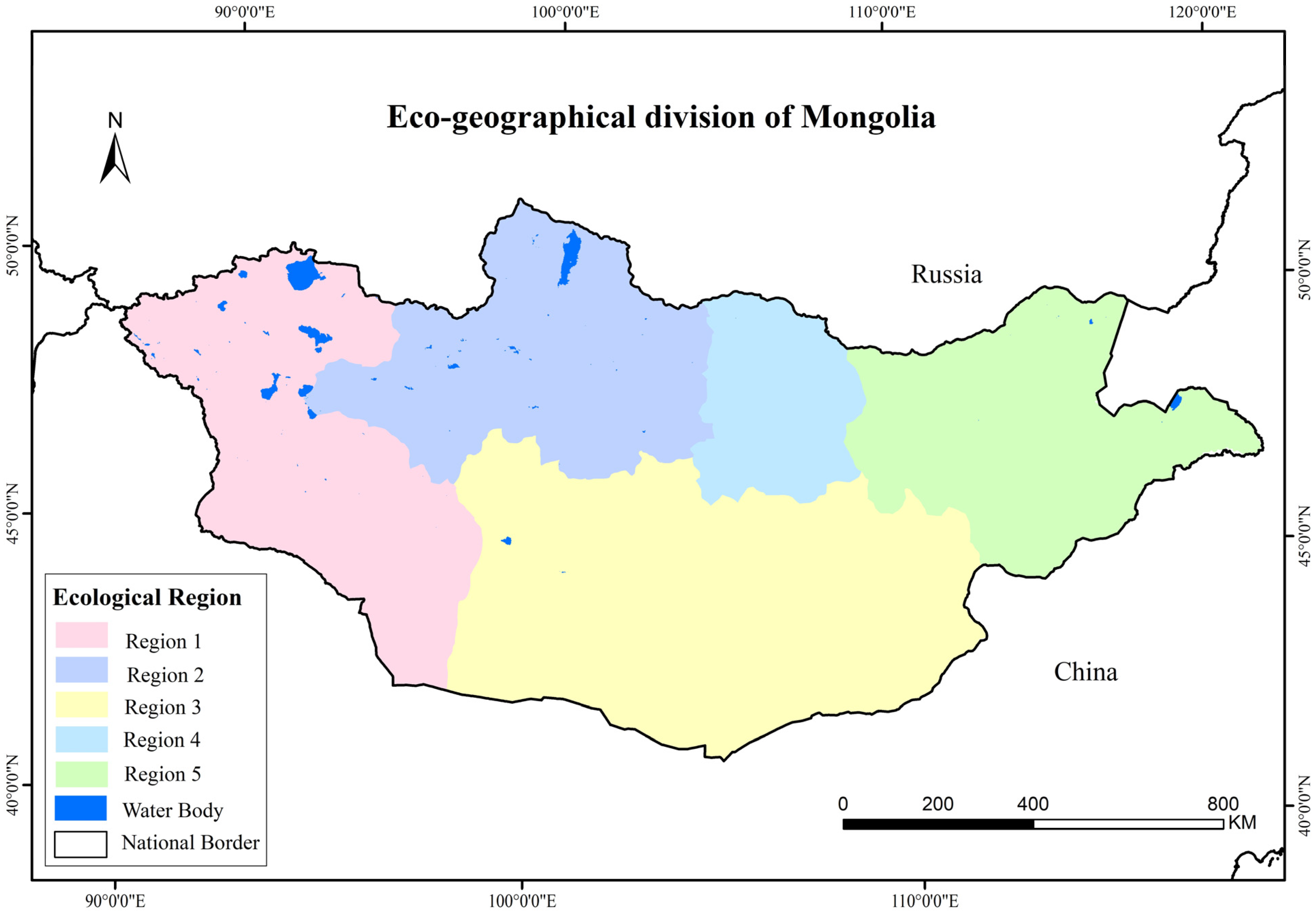
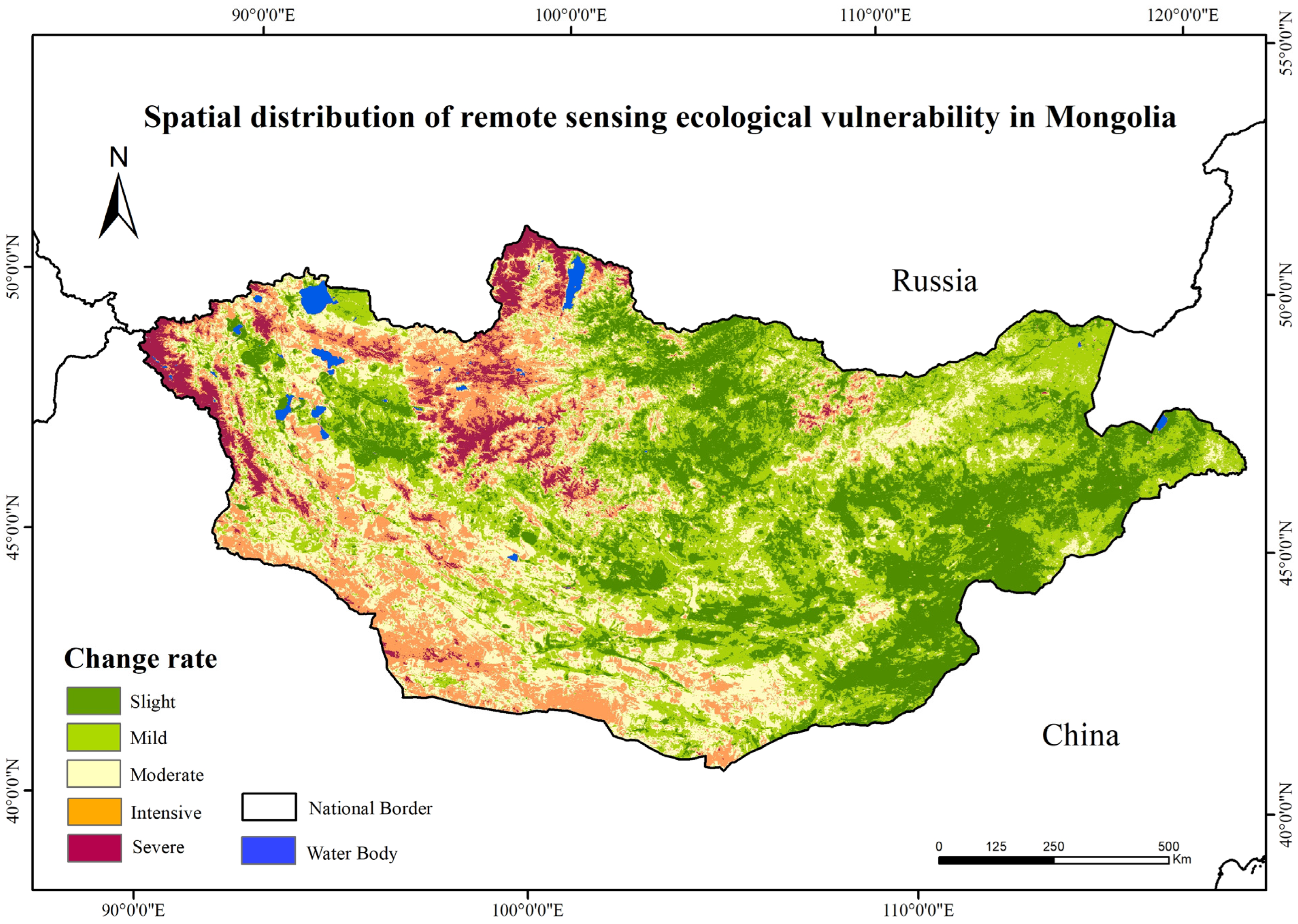
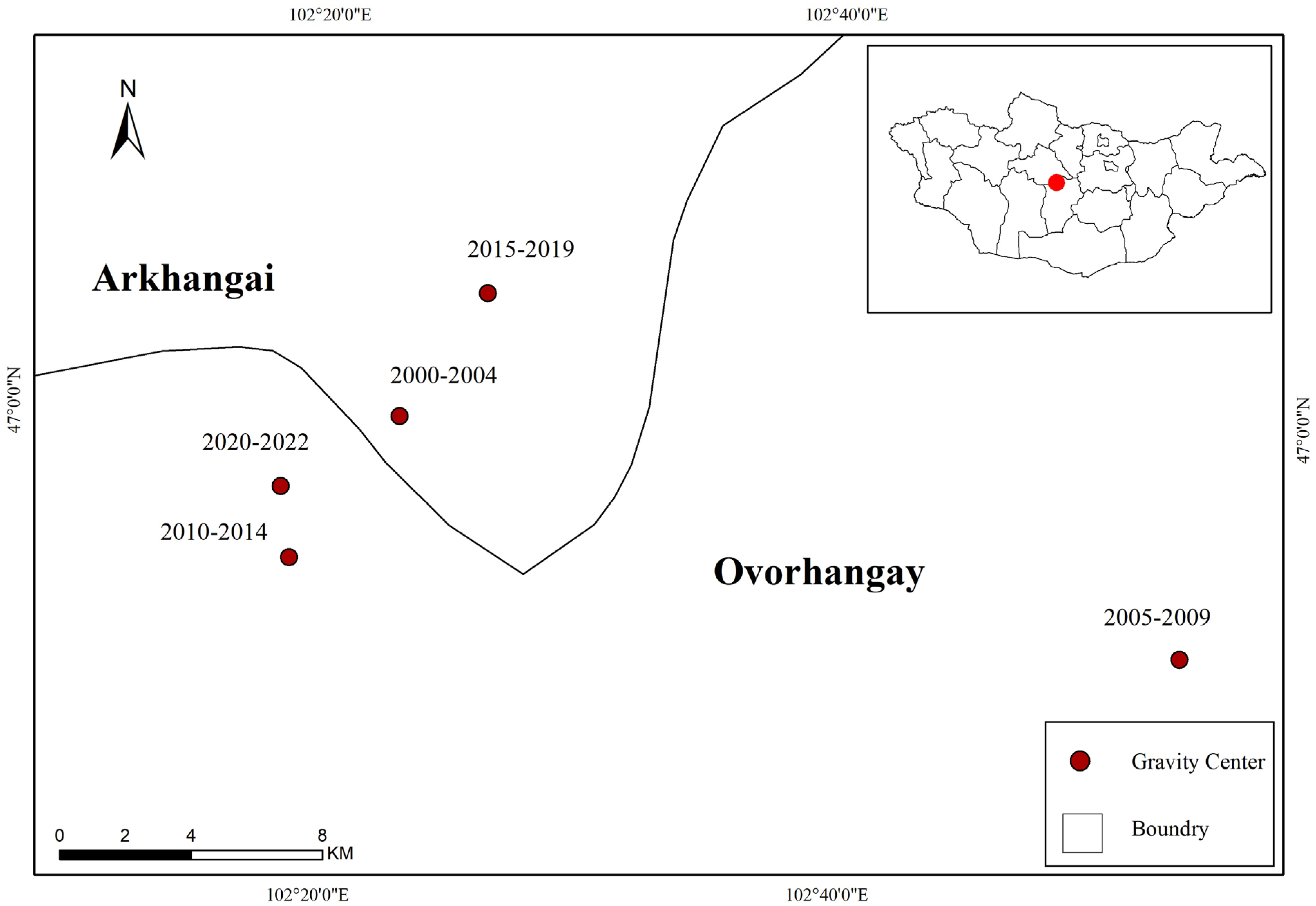

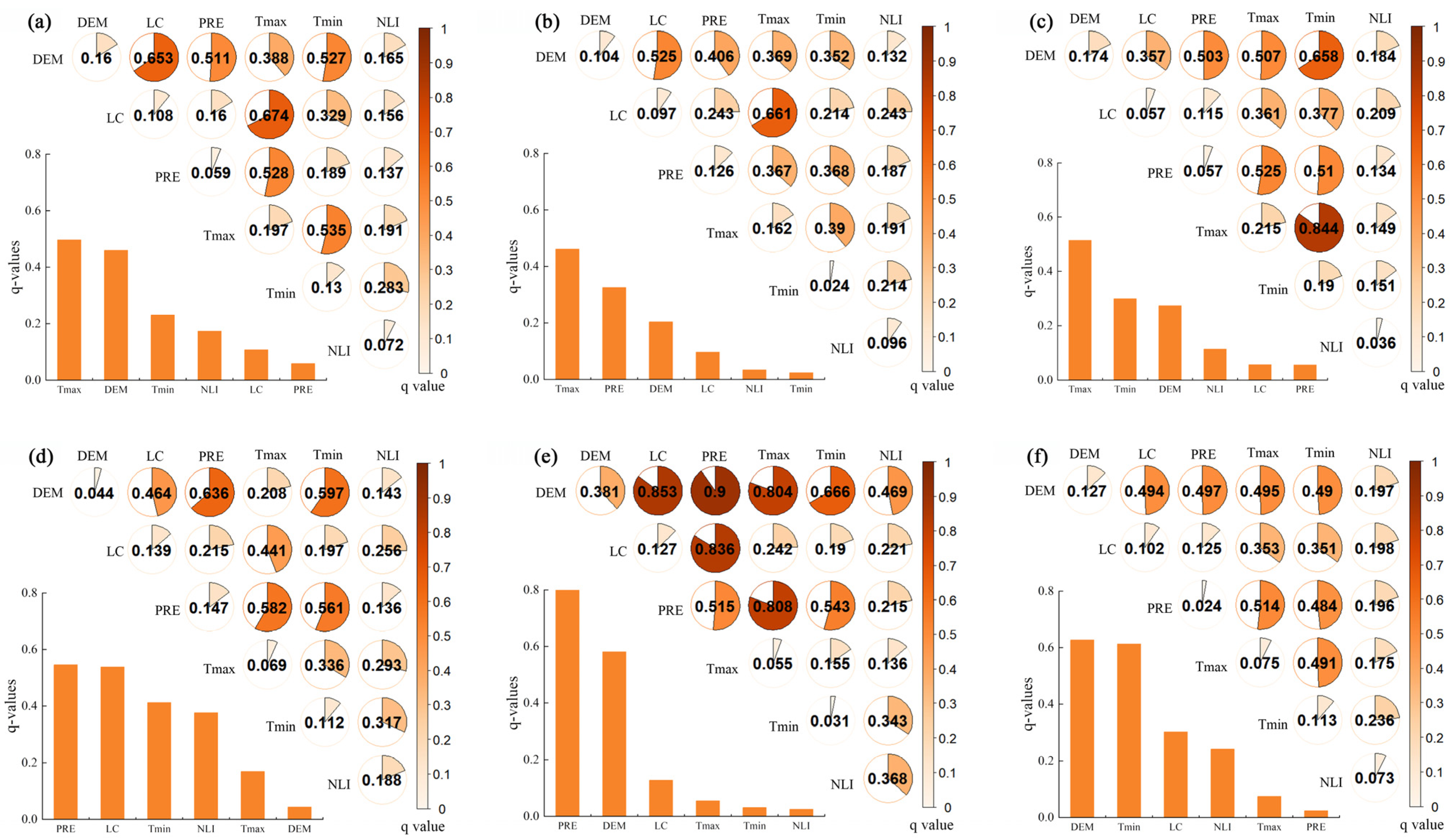
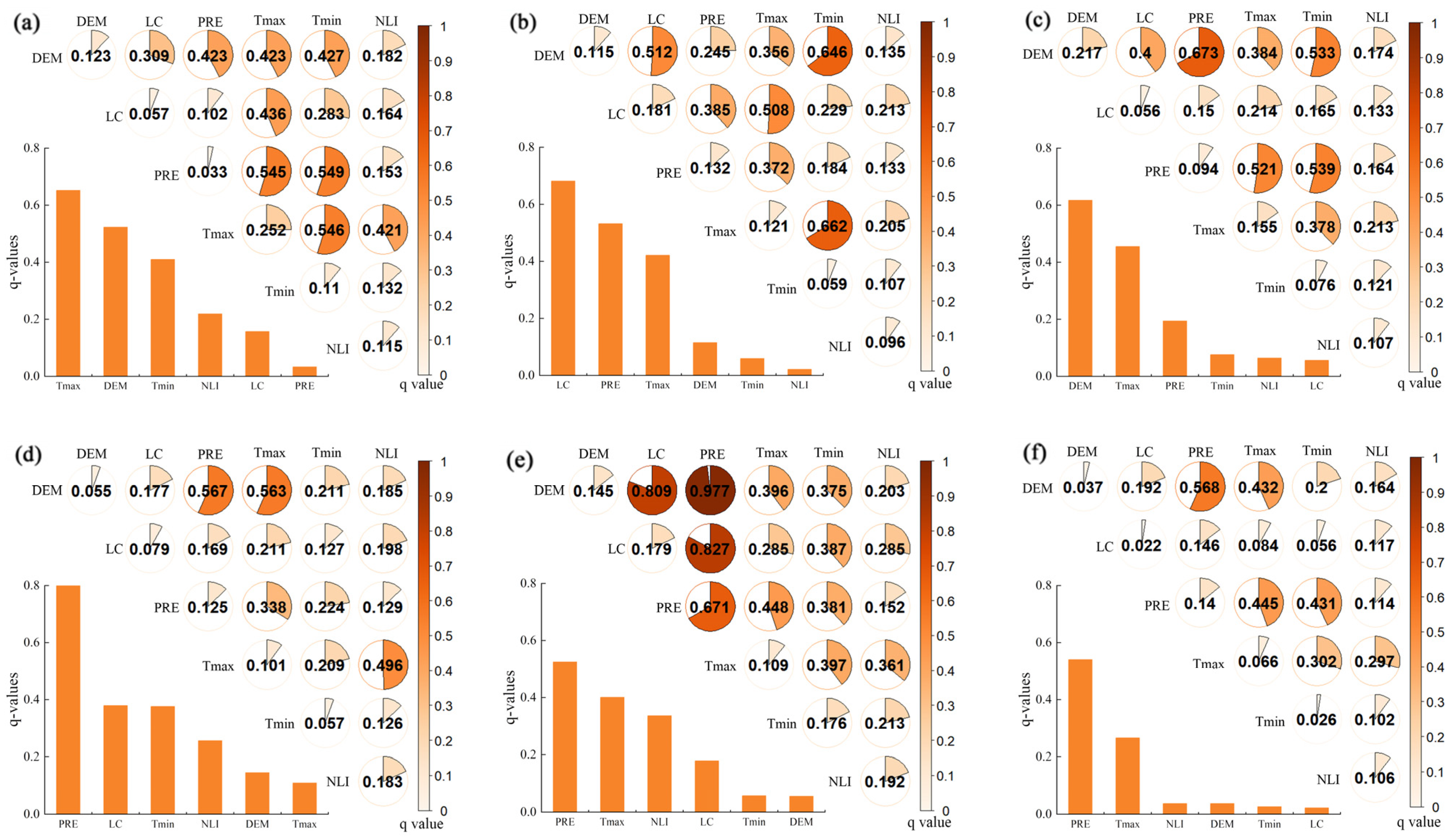
| Data | Data Description | Data Sources | Data Use |
|---|---|---|---|
| Digital elevation model | 500 m accuracy digital elevation model in Mongolia | General Bathymetric Chart of the Oceans | Attributional analysis |
| Maximum temperature (Tmax) | Global 2.5 min resolution Maximum temperature grid data | WorldClim | Attributional analysis |
| Minimum temperature (Tmin) | Global 2.5 min resolution minimum temperature grid data | WorldClim | Attributional analysis. |
| Land cover (LC) | Esri 10 m land cover data | Esri | Attributional analysis |
| Precipitation data (PRE) | Annual average precipitation data at global meteorological stations | National Centers foe Environmental | Attributional analysis |
| Night lights index (NLI) | 1 km night light data 500 m night light data | Suomi NPP/VIIRS DMSP/OLS | Attributional analysis |
| Evaluation Results | |||||||
|---|---|---|---|---|---|---|---|
| Vulnerability Levels | Slight | Mild | Moderate | Intensive | Severe | Sum | |
| Filed observed samples | Slight | 50 | 0 | 2 | 1 | 1 | 54 |
| Mild | 3 | 54 | 2 | 3 | 2 | 64 | |
| Moderate | 1 | 1 | 35 | 2 | 1 | 40 | |
| Intensive | 0 | 2 | 1 | 40 | 1 | 44 | |
| Severe | 1 | 1 | 1 | 1 | 39 | 43 | |
| Sum | 55 | 58 | 41 | 47 | 44 | 245 | |
| Year | Area | Single Factor | q Value | Interaction Factor | q Value |
|---|---|---|---|---|---|
| 2000 | Mongolia | Tmax | 0.635 | Tmax ∩ Tmin | 0.834 |
| Region I | Tmax | 0.688 | Tmax ∩ Tmin | 0.821 | |
| Region II | Tmin | 0.531 | Tmin ∩ PRE | 0.822 | |
| Region III | DEM | 0.523 | DEM ∩ PRE | 0.689 | |
| Region IV | PRE | 0.663 | PRE ∩ DEM | 0.872 | |
| Region V | DEM | 0.472 | DEM ∩ PRE | 0.557 | |
| 2010 | Mongolia | Tmax | 0.497 | Tmax ∩ LC | 0.674 |
| Region I | Tmax | 0.462 | Tmax ∩ LC | 0.661 | |
| Region II | Tmax | 0.515 | Tmax ∩ Tmin | 0.844 | |
| Region III | PRE | 0.547 | PRE ∩ DEM | 0.636 | |
| Region IV | PRE | 0.815 | PRE ∩ DEM | 0.9 | |
| Region V | DEM | 0.627 | Tmax ∩ PRE | 0.514 | |
| 2022 | Mongolia | Tmax | 0.652 | Tmin ∩ PRE | 0.549 |
| Region I | LC | 0.681 | DEM ∩ Tmin | 0.646 | |
| Region II | DEM | 0.671 | DEM ∩ PRE | 0.673 | |
| Region III | PRE | 0.525 | PRE ∩ DEM | 0.567 | |
| Region IV | PRE | 0.871 | PRE ∩ DEM | 0.977 | |
| Region V | PRE | 0.540 | PRE ∩ DEM | 0.569 |
Disclaimer/Publisher’s Note: The statements, opinions and data contained in all publications are solely those of the individual author(s) and contributor(s) and not of MDPI and/or the editor(s). MDPI and/or the editor(s) disclaim responsibility for any injury to people or property resulting from any ideas, methods, instructions or products referred to in the content. |
© 2025 by the authors. Licensee MDPI, Basel, Switzerland. This article is an open access article distributed under the terms and conditions of the Creative Commons Attribution (CC BY) license (https://creativecommons.org/licenses/by/4.0/).
Share and Cite
Han, J.; Guo, B.; Pan, L.; Han, B.; Xu, T. Change Patterns of Ecological Vulnerability and Its Dominant Factors in Mongolia During 2000–2022. Remote Sens. 2025, 17, 1248. https://doi.org/10.3390/rs17071248
Han J, Guo B, Pan L, Han B, Xu T. Change Patterns of Ecological Vulnerability and Its Dominant Factors in Mongolia During 2000–2022. Remote Sensing. 2025; 17(7):1248. https://doi.org/10.3390/rs17071248
Chicago/Turabian StyleHan, Jing, Bing Guo, Lizhi Pan, Baomin Han, and Tianhe Xu. 2025. "Change Patterns of Ecological Vulnerability and Its Dominant Factors in Mongolia During 2000–2022" Remote Sensing 17, no. 7: 1248. https://doi.org/10.3390/rs17071248
APA StyleHan, J., Guo, B., Pan, L., Han, B., & Xu, T. (2025). Change Patterns of Ecological Vulnerability and Its Dominant Factors in Mongolia During 2000–2022. Remote Sensing, 17(7), 1248. https://doi.org/10.3390/rs17071248








